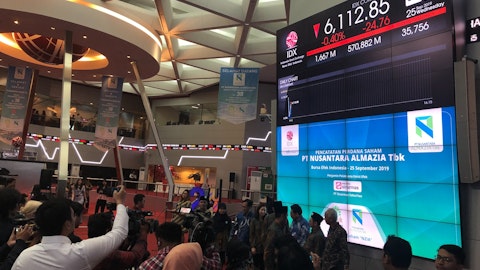Anja Soderstrom: Okay, thank you. And in terms of inventory, it seems like you are doing a great job in managing that as well. Do you think we should continue to see improvements from here or where are you targeting now?
Jure Sola: Yeah, we definitely expect to see improvements. Now with my new CFO, I should have a lot of improvements. So, no, we do expect improvements and we have programs internally that we’re working very hard on and with our customers. We learned a lot through the COVID days on how to manage it and so on. So there’s a lot of focus both on a customer side and of course on our side to make sure that we are smarter going forward how do we manage inventory, especially if we have hiccups in our industry like we had with COVID.
Anja Soderstrom: Okay, thank you. And we’re talking eventually achieving $10 billion to $12 billion revenue in a couple of years here and 6 plus percent operating margin. What kind of revenue level do you think you need for that operating margin?
Jure Sola: I think for us it’s a mix of the business, how much it comes from our technology group and how much does it come from our products. But as you can see, once we get closer to the $9 billion plus, I think last year we exited the year, almost what, 5.9%, 5.8%. But as we get to the run rate around $9 billion plus, we expect to be in that high fives, the low sixes. But the key for us is the mix. We’re investing a lot of these new technology products and our components. We are investing in some of the defense industries. We are investing into lithography. We get some European partners there that we have for lithography equipment, precision machining and so on. So we got a lot of on our plate and I think as long as those things come together, the way — because we already spend a lot of the money for growth, so we got to grow.
I mean, that’s the whole focus right now internally, but we got to grow smart. We don’t want to grow for a growth sake. We got to make sure that we have respectable margins.
Anja Soderstrom: Okay. Thank you. That was all from me. I’ll get back in queue.
Jure Sola: All right. Operator, we have time for one more question.
Operator: Thank you. [Operator Instructions] Your next question comes from the line of Ruplu Bhattacharya from Bank of America. Your line is now open.
Jure Sola: Hello, Ruplu.
Ruplu Bhattacharya: Hi, Jure.
Jure Sola: It’s good to have you back.
Ruplu Bhattacharya: Yeah, thanks for taking my questions. Appreciate it. I have a few questions. Let me start by welcoming Jon. Thanks. It’s good to have you on board. Maybe can you just tell us what your maybe top two, three focus areas are over the next 12 months?
Jon Faust: Yeah, thank you, Ruplu. It’s nice to connect with you and looking forward to speaking more with you. Couple of things, right? So number one, I would just say learning the business, right? That is the top priority for me. As I mentioned in my prepared remarks, I’ve been here for about six weeks and been spending a lot of time meeting with the leadership team. In my first week here, I was able to make a trip down to the Guadalajara. And that was very important, just to be able to see our capabilities firsthand at one of our major facilities. And I’ve done some in the Bay Area too. And then really just getting into the details of the business. So just a couple of weeks back, as we were preparing for this earnings call, kind of in the normal course of business, we went through all of our quarterly business reviews.
So that was a great opportunity for me to dig in deep to all the respective divisions, learn about what’s happening in the market, what’s going on with our customers, and helping to decide what our priorities need to be, right, to drive some of the things Jure was just talking about with Anja as an example, where do we see opportunity to drive operational improvements, whether it be in inventory or otherwise?
Ruplu Bhattacharya: Got it. Let me ask you another question and either you or Jure can chime in. So this quarter, the CPS segment saw about 220 basis points of sequential improvement on revenues that were sequentially down. I mean part of this you said is mixed, part of this is operational improvements. I’m trying to see if you can parse that out because if we look from 1Q to 2Q, as you’ve — in years past, you’ve had margins decline. So how much of this is structurally sustainable at this 13% level and how would you characterize this as mix-related versus operational — more structural improvement?
Jure Sola: Yeah. Ruplu, let me — this is Jure. Let me kind of give you an overview of what’s going on last quarter. As we said, definitely there were some inventory adjustments that affected the revenue for us, similar to the other businesses, we believe that our component business, we’re starting to see light end of the tunnel, we seeing, because when you — as the demand comes back, it’s going to come in our component businesses first, okay? So we’re starting to see some of that right now. So the key to that, our goal for our components, products, and services, Ruplu, is to get that minimum 15%. So yes, it is sustainable. And I think it’s now for us, it’s all about getting the revenue. We might have short-term plus and minus percentages there up and down but I think the longer term, just programs that we are working on and what we have in front of us and investments that we already made, Ruplu, into our factories.



